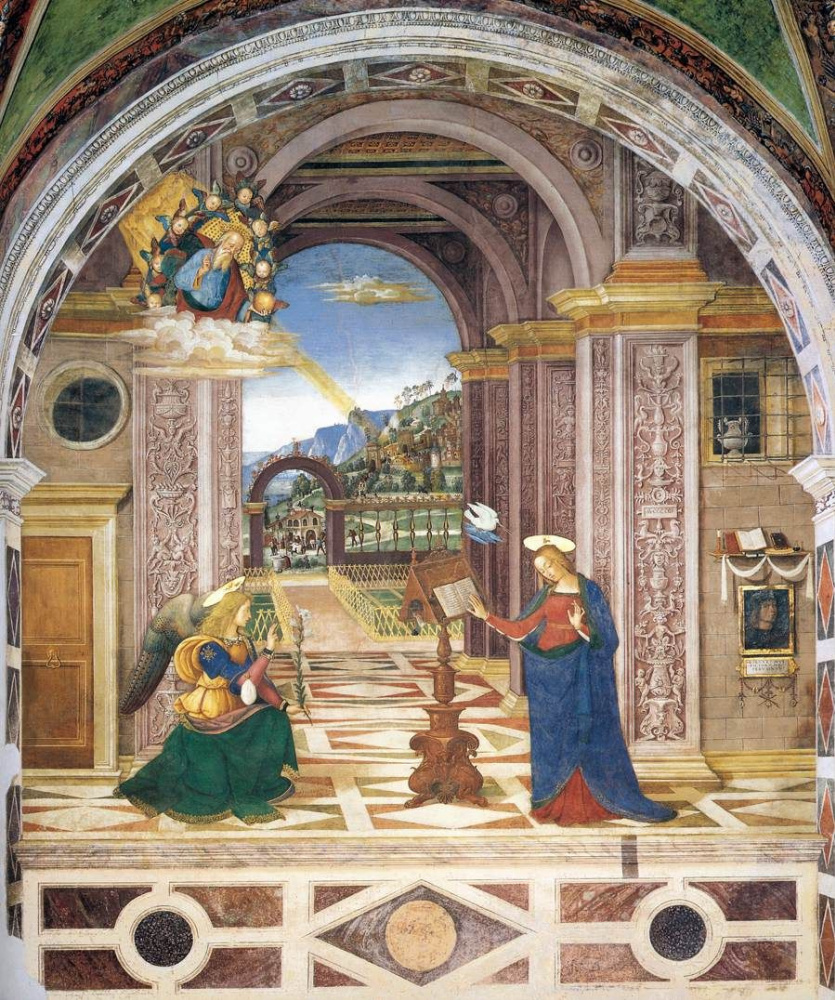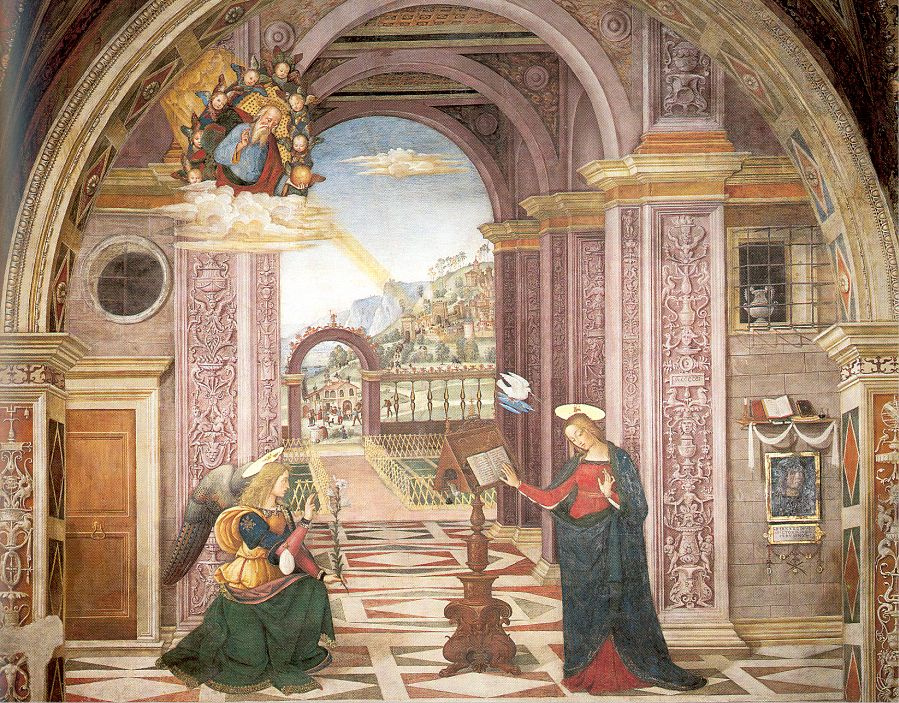log in
Enter site
Login to use Arthive functionality to the maximum
The Annunciation
Pinturicchio • Peinture, 1501
Descriptif de la toile «The Annunciation»
Small Italian town of Spello, 30 km from Perugia, famous for its streets, ablaze with colour, and excellent olive oil. And tourists from around the world leads to the Basilica of Santa Maria Maggiore, built on the site of an ancient pagan temple of the goddesses Juno and Vesta. Once in the Church there were several chapels, but not all survived to the present day: they were walled up.
Fortunately, survived the Baglioni chapel decorated with paintings of Pinturicchio. He worked there in 1501, at the invitation of the local priest, Troilo Baglioni, whose surname gave the name to the structure (later he was appointed Bishop of Perugia). For the colorful images on the walls of the chapel received a second name – Capella Bella ("beautiful", "beautiful"). Worship in it was done until 1874.
By the way, the portrait of the customer Pinturicchio was placed on one of the works. On the left side of the mural "Christ among the teachers" you can see he in person (in black robes among a group of people). Similar overtures to donors in the form of portraits were quite popular in the Italian Early Renaissance. But "the Annunciation" the painter went even further, "hanging" on the wall to the right of the virgin Mary your self-portrait.
It is worth mentioning that Pinturicchio is not the first came up with this idea. The Italians of the Quattrocento often included themselves and their family members in group compositions on monumental paintings and even wrote myself with the saints. First, who disguised himself under the easel painting to the fresco, was Perugino – during the process of painting the halls of the techniques of the exchange management Board in Perugia, where he worked in 1497 – 1500. Just one year later, this trick was repeated, and Pinturicchio, though in a more modest format, limited only by its name in the caption: "Bernardino. The painter from Perugia". Perugino same provided your self-portrait plate with the words: "Pietro peradzynski excellent painter. That lost art, revived it, zhivopisuya. What was not in it, he re-invented".
Earlier, in 1492 Pinturicchio wrote the fresco "the Annunciation" in the process of painting the Apartment Borgia in the Vatican. Common between these two images, only the plot. Archangel Gabriel holding a Lily flower – symbol of purity of the virgin Mary. At the top we see God the Father surrounded by cherubim, from him to the mother of God the Holy Spirit descends in the form of a white dove. The back of both frescoes is a landscape with cliffs, ancient buildings and trees.
The similarities end and the differences begin. If the mural from the Apartment Borgia downright stuns his excessive ornamentation and a dazzling gold, the "Annunciation" in the Umbrian town of Spello, where more restrained and temperate in the fine means. It has more space and space that gives more freedom in terms of composition, but, on the other hand, significantly shifts the semantic emphasis. Due to the fact that Pinturicchio is fond of drawing actions on a landscape, he pulls a significant portion of the attention on himself.
The Annunciation – when the Archangel Gabriel brings the virgin the news that she was destined to become the Mother of the Saviour, is one of the key events of the New Testament and basic Christian doctrine episode as a whole. Here it is perceived mundane-prosaic, like Mary every day is the Archangel with the good news. View slides past the main characters to the background, I want to consider what is happening outside the main plot, to see what occupied people on the street.
And while "the Annunciation" from the property the Vatican can catch the boredom almost perfect symmetry (which, frankly, Pinturicchio loved to flaunt his decorative and monumental painting), it is "closer to", as more fully conveys the solemnity and significance of the sacred for all Christians now. Let and achieves this fairly crude methods. "You will not soon see a more sumptuous but barbaric in its splendor frescoes than in the Borgia apartments in the Vatican, where glittering gold ornament merges with the invaluable ultramarine"– says the Vatican's "Annunciation" Pinturicchio scholar of the Italian Renaissance by Bernard Berenson.
But which is a "free paraphrase" the gospel Umbrian fresco more interesting in terms of composition (despite the very free treatment of the painter with the perspective) and is of greater interest for detailed study. Who are these people, peacefully Diners during the epoch-making incident? What a vase on a self-portrait of the artist and why she was placed behind bars? And how, in fact, was the portrait of the Renaissance in the depiction of events that took place approximately 9 months prior to the onset of ad?
Author: Natalia Azarenka
Fortunately, survived the Baglioni chapel decorated with paintings of Pinturicchio. He worked there in 1501, at the invitation of the local priest, Troilo Baglioni, whose surname gave the name to the structure (later he was appointed Bishop of Perugia). For the colorful images on the walls of the chapel received a second name – Capella Bella ("beautiful", "beautiful"). Worship in it was done until 1874.
By the way, the portrait of the customer Pinturicchio was placed on one of the works. On the left side of the mural "Christ among the teachers" you can see he in person (in black robes among a group of people). Similar overtures to donors in the form of portraits were quite popular in the Italian Early Renaissance. But "the Annunciation" the painter went even further, "hanging" on the wall to the right of the virgin Mary your self-portrait.
It is worth mentioning that Pinturicchio is not the first came up with this idea. The Italians of the Quattrocento often included themselves and their family members in group compositions on monumental paintings and even wrote myself with the saints. First, who disguised himself under the easel painting to the fresco, was Perugino – during the process of painting the halls of the techniques of the exchange management Board in Perugia, where he worked in 1497 – 1500. Just one year later, this trick was repeated, and Pinturicchio, though in a more modest format, limited only by its name in the caption: "Bernardino. The painter from Perugia". Perugino same provided your self-portrait plate with the words: "Pietro peradzynski excellent painter. That lost art, revived it, zhivopisuya. What was not in it, he re-invented".
Earlier, in 1492 Pinturicchio wrote the fresco "the Annunciation" in the process of painting the Apartment Borgia in the Vatican. Common between these two images, only the plot. Archangel Gabriel holding a Lily flower – symbol of purity of the virgin Mary. At the top we see God the Father surrounded by cherubim, from him to the mother of God the Holy Spirit descends in the form of a white dove. The back of both frescoes is a landscape with cliffs, ancient buildings and trees.
The similarities end and the differences begin. If the mural from the Apartment Borgia downright stuns his excessive ornamentation and a dazzling gold, the "Annunciation" in the Umbrian town of Spello, where more restrained and temperate in the fine means. It has more space and space that gives more freedom in terms of composition, but, on the other hand, significantly shifts the semantic emphasis. Due to the fact that Pinturicchio is fond of drawing actions on a landscape, he pulls a significant portion of the attention on himself.
The Annunciation – when the Archangel Gabriel brings the virgin the news that she was destined to become the Mother of the Saviour, is one of the key events of the New Testament and basic Christian doctrine episode as a whole. Here it is perceived mundane-prosaic, like Mary every day is the Archangel with the good news. View slides past the main characters to the background, I want to consider what is happening outside the main plot, to see what occupied people on the street.
And while "the Annunciation" from the property the Vatican can catch the boredom almost perfect symmetry (which, frankly, Pinturicchio loved to flaunt his decorative and monumental painting), it is "closer to", as more fully conveys the solemnity and significance of the sacred for all Christians now. Let and achieves this fairly crude methods. "You will not soon see a more sumptuous but barbaric in its splendor frescoes than in the Borgia apartments in the Vatican, where glittering gold ornament merges with the invaluable ultramarine"– says the Vatican's "Annunciation" Pinturicchio scholar of the Italian Renaissance by Bernard Berenson.
But which is a "free paraphrase" the gospel Umbrian fresco more interesting in terms of composition (despite the very free treatment of the painter with the perspective) and is of greater interest for detailed study. Who are these people, peacefully Diners during the epoch-making incident? What a vase on a self-portrait of the artist and why she was placed behind bars? And how, in fact, was the portrait of the Renaissance in the depiction of events that took place approximately 9 months prior to the onset of ad?
Author: Natalia Azarenka




